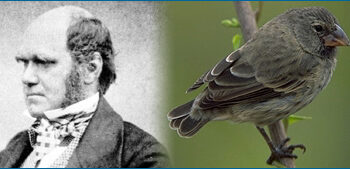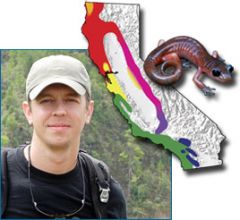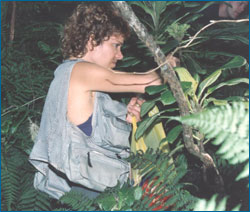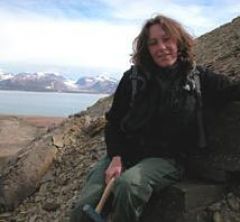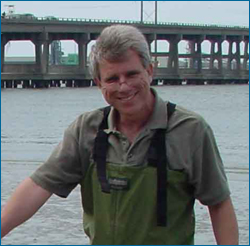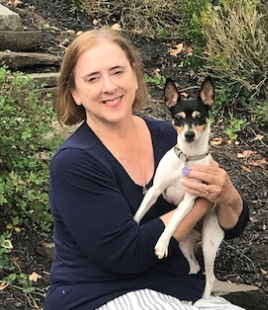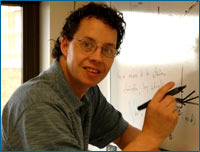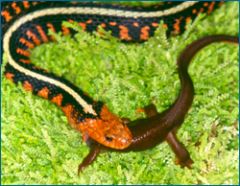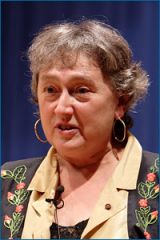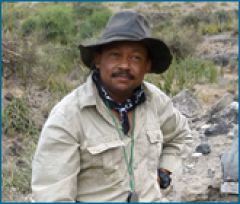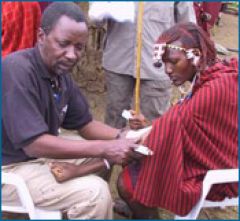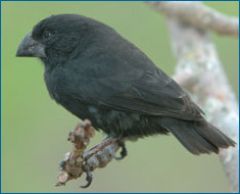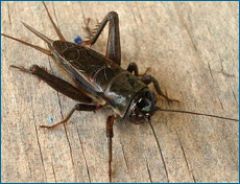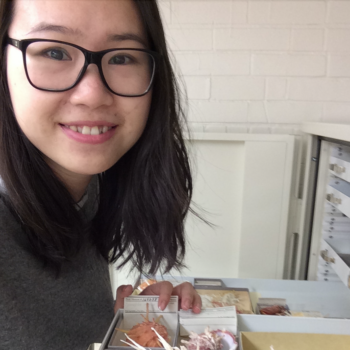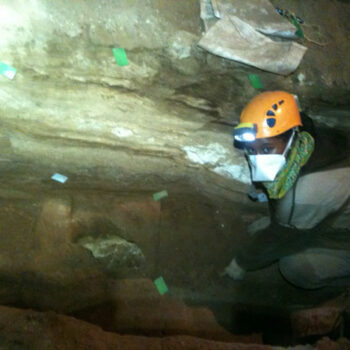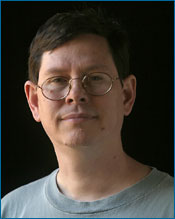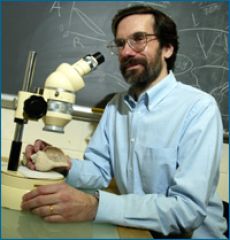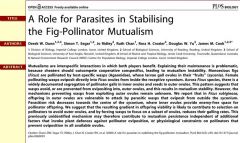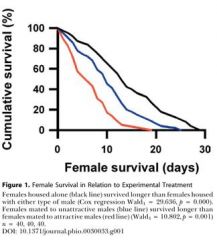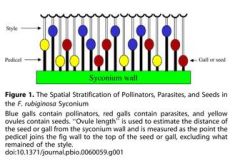Found 26 resources for the concept:
Science is a human endeavor.
¡Feliz cumpleaños número 200, Darwin!
Grade Level(s):
- 9-12
- 13-16
- General
Source:
- UC Museum of Paleontology
Resource type:
- Evo in the News article
Time: 30 minutes
Overview
Este 12 de febrero se cumplirían 200 años del nacimiento de Charles Darwin, y todo el mundo esta invitado a la fiesta. Numerosos grupos alrededor del mundo — desde niños en las escuelas primarias, hasta museos e iglesias — celebraran la ciencia de la evolución con conferencias públicas, clases, obras teatrales, exhibiciones artísticas y muchísimas galletas con forma de tortugas. 'Evolución en las noticias' de este mes contribuye a la celebración mediante la revisión de un tema cercano y querido por Darwin: los pinzones de Galápagos...
A closer look at a classic ring species: The work of Tom Devitt
Grade Level(s):
- 9-12
- 13-16
- General
Source:
- UC Museum of Paleontology
Resource type:
- Research profile
Time: 40 minutes
Overview
The Ensatina salamander has been extensively investigated because it is a ring species — a species that demonstrates how geography and the gradual accumulation of genetic differences factor into the process of speciation. Biologist Tom Devitt continues the more than 50 years of Ensatina research by applying new genetic techniques and asking new questions about this classic evolutionary example.
Aloha, spider style! The work of Rosemary Gillespie
Grade Level(s):
- 9-12
- 13-16
- General
Source:
- UC Museum of Paleontology
Resource type:
- Research profile
Time: one class period
Overview
This research profile follows Dr. Rosemary Gillespie to Hawaii as she evaluates hypotheses about the evolution of the colorful happy-face spider.
Ancient fossils and modern climate change: The work of Jennifer McElwain
Grade Level(s):
- 9-12
- 13-16
- General
Source:
- UC Museum of Paleontology
Resource type:
- Research profile
Time: 40 minutes
Overview
Wondering how global warming will affect our planet? Scientist Jennifer McElwain studies the fossil record in order to learn more about how global warming has affected life on Earth in the past and how it might affect life on Earth in the future.
Angling for evolutionary answers: The work of David O. Conover
Grade Level(s):
- 9-12
- 13-16
- General
Source:
- UC Museum of Paleontology
Resource type:
- Research profile
Time: 30 minutes
Overview
Human activity has certainly affected our physical environment - but it is also changing the course of evolution. This research profile follows scientist David O. Conover as he investigates the impact of our fishing practices on fish evolution and discovers what happened to the big ones that got away.
Artificial Selection with Elaine Ostrander and Team
Grade Level(s):
- 9-12
- 13-16
- Advanced
Source:
- UC Museum of Paleontology
Resource type:
- Classroom activity
Time: 1 hr
Overview
In this article (and the linked assignments and student readings), students examine and interpret data that the team used to study the genes undergoing artificial selection during the development of different dog breeds. Use the tabs at the bottom of the feature to find related videos, assignments, and lessons to build this example into a lesson sequence on artificial selection.
Battling bacterial evolution: The work of Carl Bergstrom
Grade Level(s):
- 9-12
- 13-16
- General
Source:
- UC Museum of Paleontology
Resource type:
- Research profile
Time: 30-40 minutes
Overview
This research profile examines how the scientist Carl Bergstrom uses computer modeling to understand and control the evolution of antibiotic resistant bacteria in hospitals.
Biological warfare and the coevolutionary arms race
Grade Level(s):
- 9-12
- 13-16
- Advanced
- General
Source:
- UC Museum of Paleontology
Resource type:
- Article
Time: 45 minutes
Overview
The rough-skinned newt looks harmless enough but is, in fact, packed full of one of the most potent neurotoxins known to man. Find out how an evolutionary arms race has pushed these mild-mannered critters to the extremes of toxicity and how evolutionary biologists have unraveled their fascinating story.
Cells within cells: An extraordinary claim with extraordinary evidence
Grade Level(s):
- 13-16
- Advanced
- General
Source:
- Understanding Science
Resource type:
- Article
Time: 30 minutes
Overview
When biologist Lynn Margulis revived the strange-sounding idea that the merging of cells played a prominent role in the evolution of complex life, the scientific community roundly rejected the notion. Today, this idea is accepted as a textbook fact. Learn more about the evidence and social factors that spurred the acceptance of this key aspect of evolutionary theory.
This article is available from the Understanding Science website.
CSI: Olduvai Gorge. The work of Jackson Njau
Grade Level(s):
- 9-12
- 13-16
Source:
- UC Museum of Paleontology
Resource type:
- Research profile
Time: 40 minutes
Overview
This research profile follows paleoanthropologist Jackson Njau as he investigates ancient predators, like crocodiles and large cats, in an effort to understand how these organisms shaped the evolution of our human ancestors.
Evo in the news: Got lactase?
Grade Level(s):
- 9-12
- 13-16
- Advanced
- General
Source:
- UC Museum of Paleontology
Resource type:
- Evo in the News article
Time: 20 minutes
Overview
The ability to digest milk is a recent evolutionary innovation that has spread through some human populations. This news brief from April 2007 describes how evolution has allowed different human populations to take advantage of the nutritional possibilities of dairying and links evolution with the prevalence of lactose tolerance among people of different ethnicities.
Evo in the news: Happy 200th, Darwin!
Grade Level(s):
- 9-12
- 13-16
- General
Source:
- UC Museum of Paleontology
Resource type:
- Evo in the News article
Time: 30 minutes
Overview
This news brief, from February 2009, celebrates Darwin's bicentennial by examining what we've learned about the evolution of the Galapagos finches since Darwin's time.
Evo in the news: Quick evolution leads to quiet crickets
Grade Level(s):
- 9-12
- 13-16
- General
Source:
- UC Museum of Paleontology
Resource type:
- Evo in the News article
Time: 20 minutes
Overview
The tropical island of Kauai has always been a quiet place, but now it may be getting even more quiet. This news brief, from December 2006, reveals how Kauai's cricket population has evolved into a "chirpless" variety in just a few years.
Extinction vulnerability with Shan Huang, David Jablonski, and Stewart Edie
Grade Level(s):
- 9-12
- 13-16
Source:
- UC Museum of Paleontology
Resource type:
- Article
- Classroom activity
Time: 1.5 hrs
Overview
In this article (and the linked assignments and student readings), students examine and interpret data that Shan, David, and Stewart used to investigate whether the mollusk species that humans eat are inherently vulnerable to extinction. Use the tabs at the bottom of the feature to find related videos, assignments, and lessons to build this example into a lesson sequence on extinction.
Extinction with Melissa Kemp and Liz Hadly
Grade Level(s):
- 9-12
- 13-16
Source:
- UC Museum of Paleontology
Resource type:
- Article
- Classroom activity
Time: 1.5 hours
Overview
In this article (and the linked assignments and student readings), students examine and interpret data that Melissa and Liz used to study the extinction bias in Caribbean lizards. Use the tabs at the bottom of the feature to find related videos, assignments, and lessons to build this example into a lesson sequence on extinction.
From the origin of life to the future of biotech: The work of Andy Ellington
Grade Level(s):
- 9-12
- 13-16
- General
Source:
- UC Museum of Paleontology
Resource type:
- Research profile
Time: 30-40 minutes
Overview
This research profile examines how scientist Andy Ellington has co-opted the power of artificial selection to construct new, useful molecules in his lab. The results of his work could help protect us from terrorist attacks and fight HIV and cancer.
High altitude adaptations: The work of Emilia Huerta-Sánchez
Grade Level(s):
- 13-16
- Advanced
Source:
- UC Museum of Paleontology
Resource type:
- Research profile
Time: 30 minutes
Overview
This research profile follows statistician and population geneticist Emilia Huerta-Sánchez as she studies the adaptations that allow Tibetan highlanders to live 13,000 feet above sea level without developing altitude sickness.
How boogieing birds evolved: The work of Kim Bostwick
Grade Level(s):
- 9-12
- 13-16
- General
Source:
- UC Museum of Paleontology
Resource type:
- Research profile
Time: 30 minutes
Overview
This research profile follows ornithologist Kim Bostwick through the jungles of Ecuador and the halls of museums as she investigates the evolution of an exotic bird's complex mating dance.
How to survive a mass extinction: The work of David Jablonski
Grade Level(s):
- 9-12
- 13-16
- General
Source:
- UC Museum of Paleontology
Resource type:
- Research profile
Time: 40 minutes
Overview
Through detailed analysis of patterns in the fossil record, scientist David Jablonski reconstructs the rules that helped dictate who lived and died in past mass extinctions. This research profile describes his surprising discoveries and their disturbing implications for the biodiversity crisis today.
Journal Club Toolkit
Grade Level(s):
- 13-16
Source:
- UC Museum of Paleontology
Resource type:
- Annotated journal article
Time: Several class periods
Overview
This set of teaching materials aims to help instructors engage their students with the primary literature in evolutionary biology through a "journal club" that can be implemented in a discussion section or smaller class. It includes several helpful tools: annotated articles, a reading guide, additional suggested reading, and tips for students leading a discussion of a journal article.
Mate choice and fitness consequences
Grade Level(s):
- 13-16
Source:
- UC Museum of Paleontology
Resource type:
- Annotated journal article
Time: 1 hour
Overview
Students read a 2005 paper on the fitness consequences of mate choice alongside an interactive guide that asks the reader to answer key questions about each section of the article.
Natural selection from the gene up: The work of Elizabeth Dahlhoff and Nathan Rank
Grade Level(s):
- 9-12
- 13-16
- Advanced
Source:
- UC Museum of Paleontology
Resource type:
- Research profile
Time: 30 minutes
Overview
Find out how we investigate evolutionary adaptations by following two scientists and their team as they figure out how the willow leaf beetle survives in different climates.
Sexual Selection with Maydianne Andrade
Grade Level(s):
- 9-12
- 13-16
- Advanced
Source:
- UC Museum of Paleontology
Resource type:
- Classroom activity
Time: 1 hour
Overview
In this article (and the linked assignments and student readings), students examine and interpret data that Maydianne collected to help her figure out why redback spiders evolved a mating behavior in which the male spider is often killed by the female spider. Use the tabs at the bottom of the feature to find related videos, assignments, and lessons to build this example into a lesson sequence on sexual selection.
Stabilization of the fig-pollinator mutualism
Grade Level(s):
- 13-16
Source:
- UC Museum of Paleontology
Resource type:
- Annotated journal article
Time: 1 hour
Overview
Students read a 2008 paper on the role of parasites in stabilizing the fig-pollinator mutualism alongside an interactive guide that explains each section of the paper and draws the reader's attention to important points in the article.
The causes of mutation with Molly Przeworski and Felix Wu
Grade Level(s):
- 13-16
- Advanced
Source:
- UC Museum of Paleontology
Resource type:
- Classroom activity
Time: 1.5 hours
Overview
In this article (and the linked assignments and student readings), students examine and interpret data that Molly and Felix used to study the causes of mutations that matter most for evolution. Use the tabs at the bottom of the feature to find related videos, assignments, and lessons to build this example into a lesson sequence on mutation.
The Checks Lab
Grade Level(s):
- 9-12
- 13-16
Source:
- ENSI
Resource type:
- Classroom activity
Time: One class period
Overview
Students construct plausible scenarios using bank checks to learn how human values and biases influence observation and interpretation.

